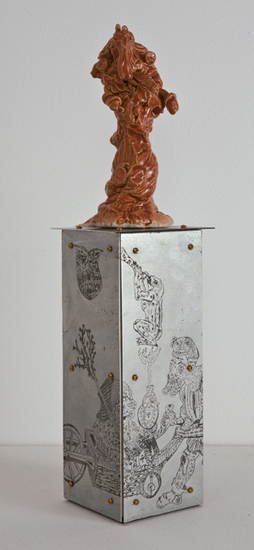Isobel Philip visits Emily Hunt’s exhibition Soiled and finds something odd…
Emily Hunt cultivates the sordid and grotesque. Her ceramics, etchings and paintings play along the edge of allure and repulsion. In Soiled, her solo exhibition at The Commercial, Sydney, the seductive force of the abject and repugnant was allowed to fester.
Emily Hunt, Dregs on Plinths, 2013, glazed stoneware object on zinc etching plate plinth, 39.00 x 15.00 x 15.00 cm
Image courtesy the artist and The Commercial Gallery, Sydney
(photo credit: Jessica Maurer)
The etymological origins of the term ‘grotesque’ are tethered to the principles of embellishment and ornamentation. Interchangeable with the word ‘arabesque’, a ‘grotesque’ is an ornate decorative pattern that was made popular in the frescos and mosaics of ancient Rome. Before the term became synonymous with the gruesome and monstrous during the 18th Century, it categorized a mode of ornamentation built around elaborate arrangements of foliage and figures. While Hunt’s work unambiguously invokes the modern definition of ‘grotesque’ — with its cohort of mutilated and disfigured characters — it also flirts with the concept of the ornament. This is not to classify her work as ‘ornamental’ or court the pejorative conclusions that are aroused when terms like ‘ornament’ and ‘decoration’ are bandied about in art criticism. Rather, it addresses Hunt’s commitment to excessive form.
In Hunt’s work, figures pile on top of one another and appendages multiply; line erupts and clustered forms swell. The body distends, playing host to a gaggle of vulgar protrusions. Even those emaciated figures on the edge of collapse, tipping into rot and decay, betray a mode of aesthetic gluttony. Form sprouts and overflows. The disembodied penises that invade her ceramic pieces are fertile even when flaccid.
This profuse fecundity finds an allegorical footnote in the pair of Janus-faced stoneware busts, The Formation of Vegetable Mould through the Action of Worms, with Observations on their Habits – Castings as Janus Heads. The title of these busts is taken from Charles Darwin’s book on earthworms, published in 1881 just before his death. In the book, Darwin outlines the relationship between a worm’s digestive system, the nutrient content of soil and the decomposition of stone. In this ecology, fertility and decay collide.
Hunt’s scatological Janus-heads (‘casting’ being the term Darwin uses for worm excrement) are tiered structures. The heads, with their phallic eyes and multiple tongues, sit atop hollow vessels. Exhibited on the same floating shelf was a collection of other stacked stoneware works. In grotto/ruin/relic, small ceramic scenes become the stratified levels of vertical structures. These are cross-sections of fragmentary landscapes, portraits of anthropological excavations that unearth the dark and dank.
These works are architectural but the body is not disavowed. Quite the contrary: this is an architecture of the body. Dismembered tongues and fingers crawl up pillars and over collapsed walls. Here, the immovable detritus of antiquity — the ruin, the relic — finds itself (quite explicitly) consumed by pulsating organic forms.
In Hunt’s work, the (parasitic) perseverance of the organic is not simply a thematic concern. It is also a technical mannerism. Working with ceramics, Hunt rejects certain rules and technical protocols. Surfaces are not smooth and the hand of the artist is not disguised. Her small ceramic figurines, coloured using semi-transparent stains rather than opaque glazes, reveal the craft and gesture of their production. With their visible fingermarks, the sculptures confess the movement (the grope) of Hunt’s hands.
There were many other layered and stratified structures among the work in the exhibition including the paintings with their conglomerates of disparate collaged elements. Vibrantly coloured allegorical scenes and enlarged heads are elevated above black and white ink drawings of tangled figures. It is the gap between the raised colour sections — where pattern is so lurid it’s almost blinding — and the sea of monochrome bodies behind it that animates this work.
In Dregs on Plinths, small ceramic figurines balance on columns made out of cut-up etching plates. While the figures melt and slump, caving in on themselves, the plinths stand erect. The tension between these two competing forces — the vertical propulsion and the collapse — speaks to the conflict between fertility and decay that permeated the entire body of work on display.
We witness the same tension in Hunt’s etchings. By leaving her etching plates in acid for too long, Hunt creates deep indentations. When each work is printed, the ink seeps and contaminates the dense and entwined forms. The lines bleed, partially obscuring the chaotic detail. Composition itself appears on the edge of collapse.
In the engraved tile works, this chaotic detail and excessive form is camouflaged. The faces scratched into the surface of each tile are almost invisible from far away. It is only once you get closer that you can see the intricate detail. All of these works are named after locations on the moon; Seething Bay, Marsh of Decay, Bay of Roughness. As line slips in and out of visibility these faces become maps, their mutilated physiognomy tracing the contours of an imagined geography. Once again, the landscape is subsumed by the body. Ever present, the body is embroiled in Hunt’s incisive study of aesthetic excess and intoxicated line. It gives form to the grotesque ornament.
Soiled
The Commercial,
December 13, 2013 – January 18, 2014

